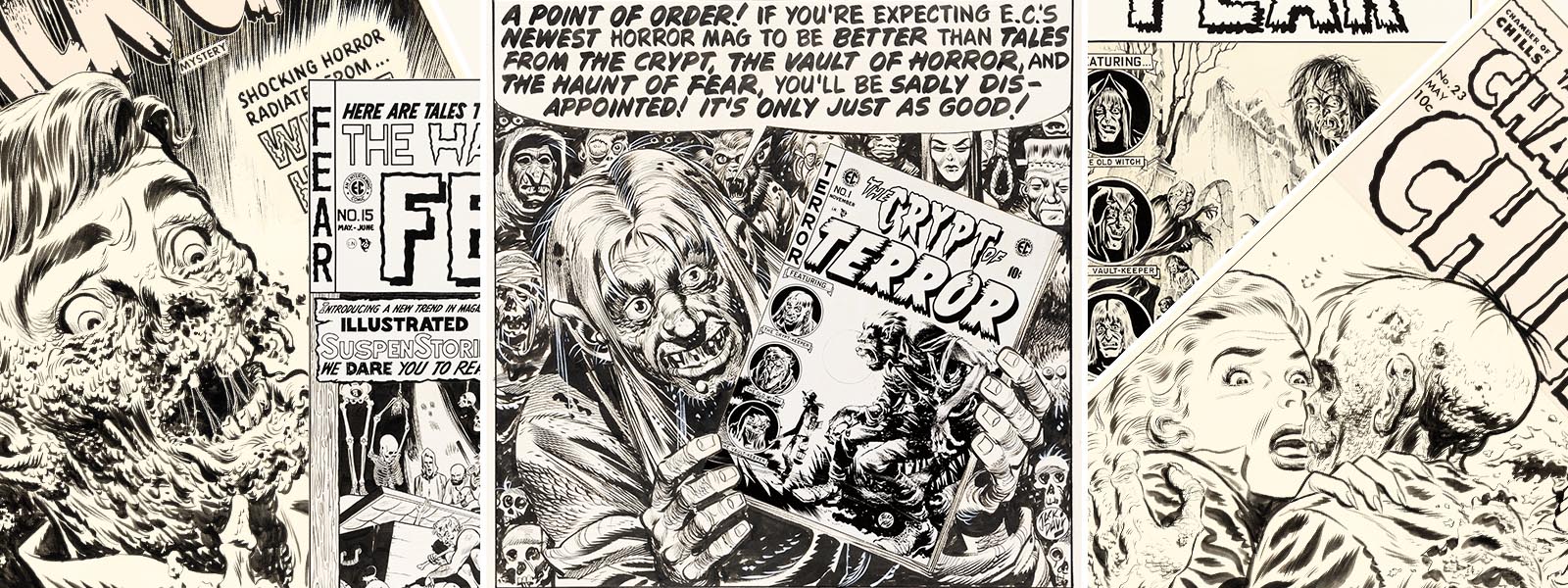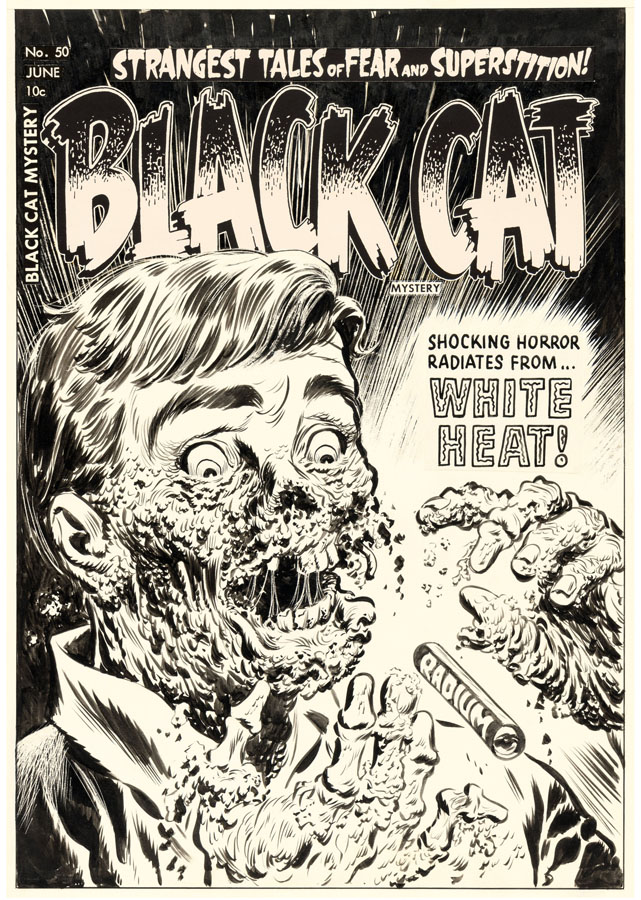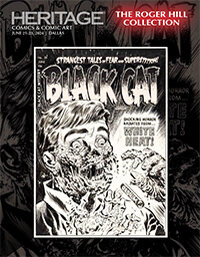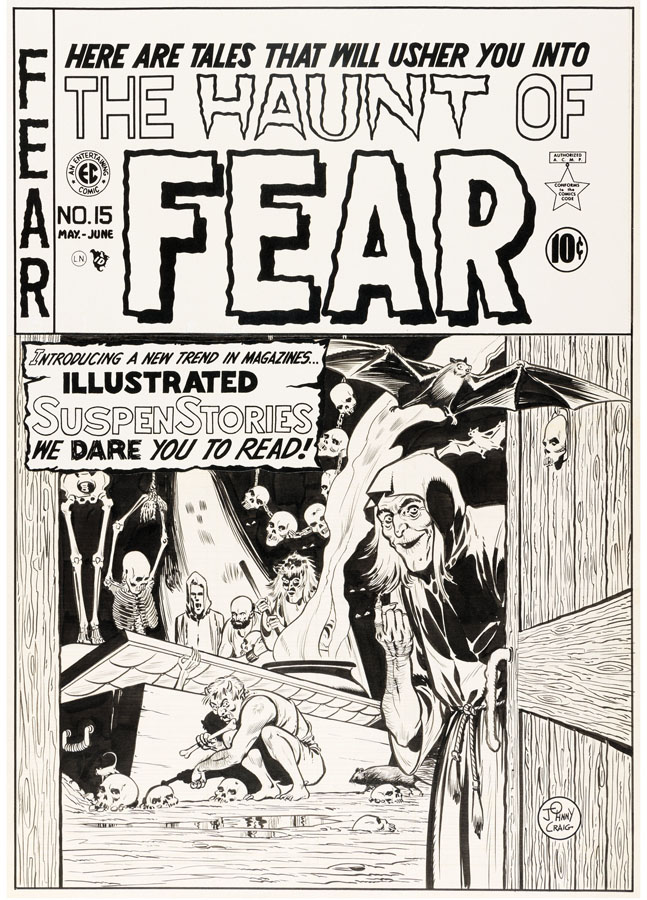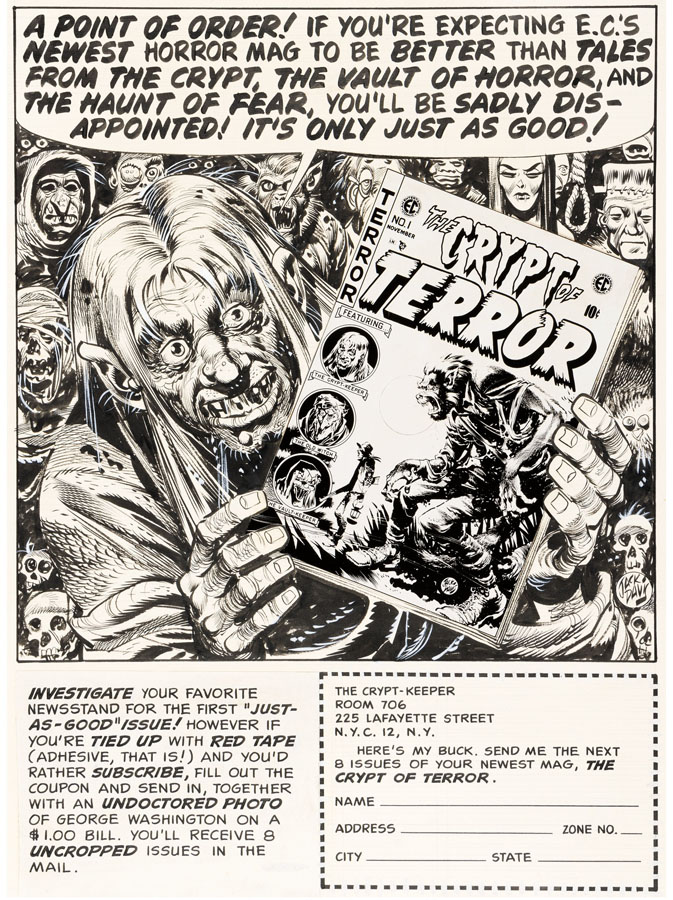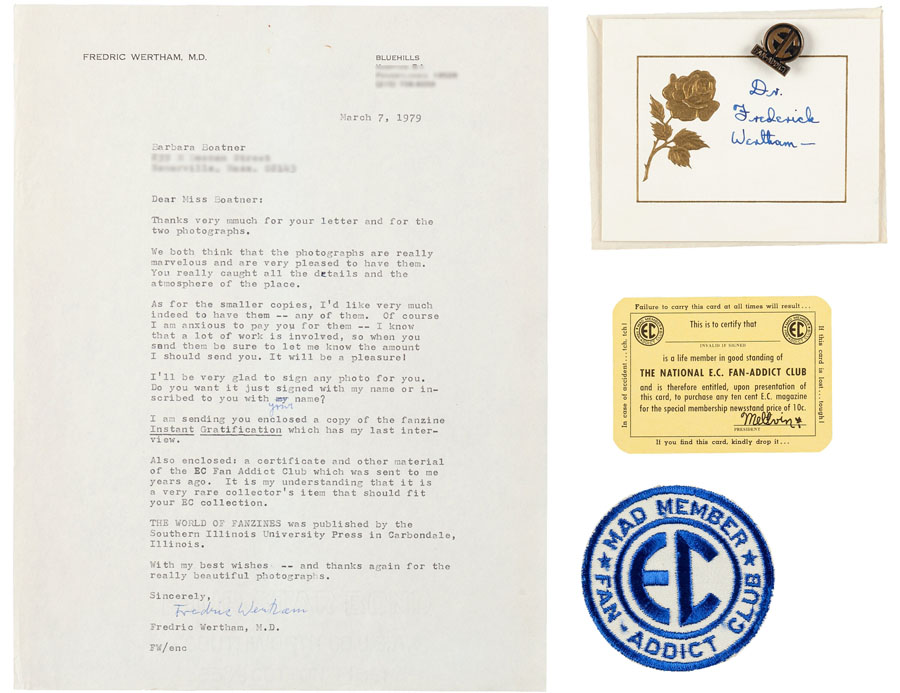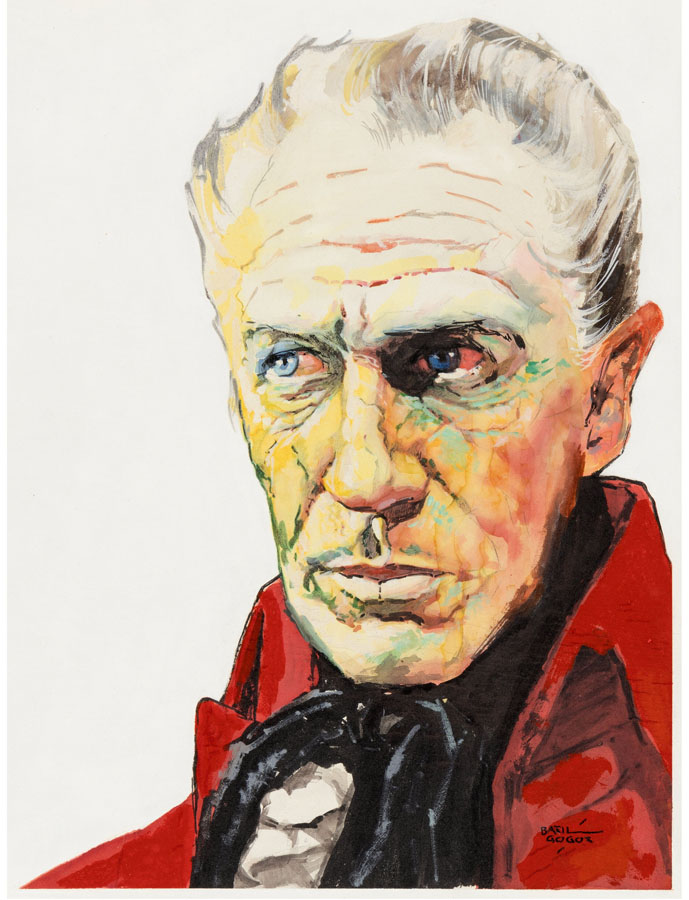THE AUTHOR AND HISTORIAN BUILT A LEGENDARY ASSEMBLAGE, INCLUDING ICONIC 1950S COVERS FROM BLACK CAT MYSTERY, CHAMBER OF CHILLS AND MORE
By Robert Wilonsky
There are many comic art collectors for whom the words “From The Roger Hill Collection” will be more than enough to explain, excite, delight. They know what those five words signify, as Hill was long regarded as one of comicdom’s most relentless and revered fans, collectors, historians and authors with an especially boundless passion for EC Comics and other titles that scared the pants off parents in the 1950s. As The Comics Journal wrote upon Hill’s death at 75 in December, “Roger’s enthusiasm for – and knowledge about – comics and comic art was both massive and infectious, and … he would leave no stone unturned in the pursuit of tracking down artwork he wanted for his collection.”
Lee Elias ‘Black Cat Mystery’ No. 50 Cover Original Art (Harvey, 1954)
It’s an assemblage that includes some of the most terrifying, tantalizing and sought-after works in the medium’s history – artwork from titles that pre-date the Comics Code Authority, pieces made by creators with permission and talent enough to explode the still-nascent medium’s boundaries. Put simply, his was the finest selection of Golden Age horror comic art – and related rarities – ever assembled. And for the first time, it heads to auction.
Heritage, entrusted with all of The Roger Hill Collection, will begin offering much of the top curated original artwork and coveted ephemera this month as one of the highlights of the June 20-23 Comics & Comic Art Signature® Auction. Hill’s assemblage is so vast and varied that Heritage will offer material through 2025, beginning with comic book and pulp events later this summer.
“Much of this material is either the absolute best of the best or rarities that only Roger could have acquired due to his seemingly endless personal connections to the artists and publishers, not to mention the earliest collectors,” says Heritage Executive Vice President Todd Hignite, who is managing the collection.
Among the auction’s more than 270 lots are some of the most iconic and important works of the Golden Age, among them Lee Elias’ original art for the white-hot, hands-and-face-melting cover of Black Cat Mystery No. 50 – a cautionary dispatch from the Atomic Age that likely stands as the most infamous pre-code horror cover of all time, with copies of the comic book itself realizing monumental prices at auction. Black Cat began its run with a female hero who might as well have been Batwoman; in time, it became one of the more horrifying reads on newsstands as evidenced by a cover that was an “outright grotesquerie,” as fan-historian Mark Brett once called it.
June 20-23, 2024
Online: HA.com/7374
INQUIRIES
Todd Hignite
214.409.1790
ToddH@HA.com
The issue, published by Richie Rich parent Harvey (!), hit newsstands in June 1954 just as Fredric Wertham was decrying comics to the Senate Subcommittee on Juvenile Delinquency and the comics industry was opting to self-censor rather than risk government regulation. And the British-born, American-raised Elias had a front-row seat to the beginning of the end of the anything-goes Golden Age: Wertham, a psychiatrist who insisted comics turned children into cruel degenerates, had singled out a few of Elias’ “deviant” pieces in his infamous book Seduction of the Innocent.
Lee Elias ‘Chamber of Chills’ No. 23 Cover Original Art (Harvey, 1954)
Elias was amid a historic run: In September 1953, Harvey published his cover of Chamber of Chills No. 19, featuring a skeletal hand toasting his bride on what looks like it might be their final anniversary among the living. (Heritage sold that original cover four years ago for $174,000.) Eight months later, Elias’ cover of Chamber of Chills No. 23 decorated newsstands with his rendering of a woman being molested by a moldering corpse – one of those age-old “tales of terror and suspense,” as the cover promised, and yet another cover singled out by collectors as a huge key from the era. That original artwork is part of Hill’s collection and stands alongside other Chamber of Chills covers featured throughout, virtually all of which are appearing on the market for the first time.
However, Hill wrote in his unfinished autobiography that his true focus and greatest passion – at least since the 1960s – was for EC Comics, especially original artwork published under William Gaines and Al Feldstein’s purview during the 1950s. Wrote Hill, “I just happen to believe that EC comics are the finest American comic books ever created.” This is why he spent decades accruing the artwork, interviewing and befriending the creators, and celebrating EC’s output with his Squa Tront and EC Fan-Addict fanzines.
Gaines’ father, M.C., launched EC as “Educational Comics” and “Entertaining Comics” in 1947; a few years later, his son Bill instituted the “new trend” takeover that gave old titles terrifying, suspenseful, weird and shocking makeovers. As Feldstein says in Grant Geissman’s eponymous biography, introducing such books as Tales from the Crypt, Weird Fantasy, Crime SuspenStories, The Haunt of Fear and others “started a game. It was all a game. We were just having a good time.”
That’s plainly evident in Johnny Craig’s cover of the horror anthology The Haunt of Fear No. 15, which hit newsstands in June 1950 and served as the title’s historic first issue after it replaced EC’s Gunfighter 14 issues into its abbreviated run. (Graham Ingels’ original cover art for December 1949’s Gunfighter No. 12 appears in this auction, serving as a stunning, sanitized reminder of the EC that was until the bodies began piling up.) Craig’s toothless Old Witch, not yet the cadaverous crone made infamous by the man called “Ghastly” Ingels, extends a bony-fingered invite to what looks like a decidedly rancid buffet. Several Haunt of Fear original covers are featured in the auction, among them Feldstein’s classic “Living Mummy” artwork that graced Issue No. 4 in December 1950 and Ingels’ August 1952 cover for The Haunt of Fear No. 14 – famous not just for its Ghastly Ingels image on the front, but also as the comic that told the Old Witch’s origin story and teased the “big secret” later revealed as MAD’s debut issue.
Hill’s collection was so expansive it even included EC covers that could have been, should have been: The Vault of Horror, among EC’s best-known titles, lasted just 40 issues. But sometime in the 1980s, Craig created a cover for a hypothetical Issue No. 41.
Among the auction’s numerous highlights is this house ad for a title EC tried to resurrect in 1954 but couldn’t ever pull from the ground: The Crypt of Terror. There had been a book by that name before, briefly, when Crime Patrol turned into The Crypt of Terror for three issues before its rechristening in the fall of 1950 as the legendary Tales from the Crypt, whose Feldstein-designed cover title and logo are featured in this auction. Gaines had hoped to revive The Crypt of Terror in late 1954, as evidenced by Jack Davis’ house ad featuring the Crypt Keeper, who promised a book that never arrived “due to the ongoing outcry against horror comics,” according to Fred von Bernewitz and Grant Geissman’s EC history Tales of Terror!
In fact, by 1955, EC had shuttered all of its “New Trend” titles, with MAD – which launched as a 10-cent comic in 1952 –the sole survivor as a 25-cent magazine. There are several early MAD men featured here, including Jack Davis’ 1956 Elvis Presley parody and Wally Wood’s Marilyn Monroe makeover from 1957.
One of the most extraordinary pieces from Hill’s collection is perhaps the least likely: Fredric Wertham’s EC Fan-Addict Club Membership Kit – including the membership card, the colorful certificate, the coveted patch and pin all contained within The Entertaining Comics Group envelope mailed to his home in 1955. According to the signed 1979 letter from Wertham to Barbara Boatner – who published underground comix price guides with Jerry Weist, Hill’s partner in the EC fanzine Squa Tront – the kit “was sent to me years ago” by someone on the inside of the company he worked tirelessly to topple. Wertham added that the kit “is a very rare collector’s item,” which he traded for some photos she’d sent him of the Senate hearings.
Another centerpiece from Hill’s collection hails from the magazine that essentially launched his lifelong obsession with a world in which the beautiful and the horrific peacefully, thoughtfully coexisted: Forrest J Ackerman’s Famous Monsters of Filmland.
In his autobiographical notes, Hill wrote that when he was 11, he and his brother Don bought Famous Monsters No. 5, which was soon “followed by anything horror or science fiction related, including comic books, movie posters, toys, stills, pulps, paperbacks, etc.” In time, Hill became particularly enamored of Basil Gogos, whose renderings of cinema’s scariest creations would become iconic and coveted by filmmakers, rock stars and lovers of the spooky stuff. Upon Gogos’ death in 2017, The New York Times hailed him as the man “who painted monsters with love.”
Hill’s collection features several original Famous Monsters covers, chief among them Gogos’ first one for the publication: 1960’s rendering of Vincent Price as Roderick Usher from director Roger Corman’s adaptation of Edgar Allan Poe’s The Fall of the House of Usher. Legend has it that publisher Jim Warren told Gogos “that his painting needed to be something new and unusual,” according to The Times’ obituary, which Gogos “found difficult to define.” Indeed, he was too embarrassed to show the publisher the final work, which appeared on the cover of Famous Monsters No. 9, and asked his agent to submit it for publication. According to Gogos, Warren called and asked the artist why he didn’t bring it himself, “so I can hug you and kiss you?”
It’s but one masterpiece among many from The Roger Hill Collection.
 ROBERT WILONSKY is a staff writer at Intelligent Collector.
ROBERT WILONSKY is a staff writer at Intelligent Collector.

